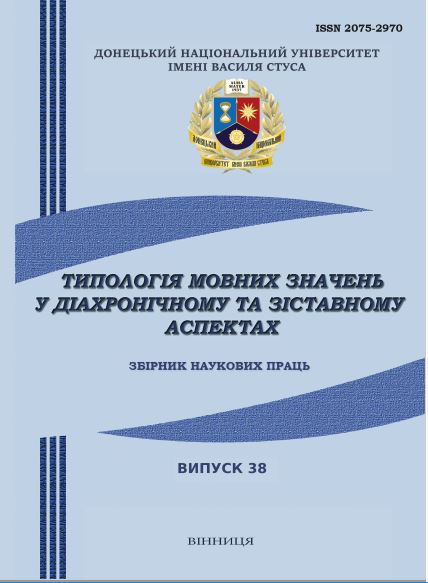Causative Constructions with the Verbs to make, to let, to have, to get.
DOI:
https://doi.org/10.31558/2075-2970.2019.38.8Keywords:
causativity, causative construction, causative situation, effective causation, causative stateAbstract
The article is devoted to the comparative research of the causative constructions with the English verbs to make, to let, to have, to get, and the Ukrainian verbs змушувати, дозволяти. The research is based on the examples of the English (to make smb do smth) and the Ukrainian (дозволяти кому-небудь робити що-небудь) constructions, the verbs to make, to let, to have, to get as a part of the causative constructions. The relevance of the article is determined by the necessity of systematic semantic analysis of the causative constructions including the above mentioned verbs. The subject of the research is the semantics and the structure of causative constructions in the English and the Ukrainian languages. The aim of the research lies in carrying out the semantic analysis of the causative constructions and revealing the common and the different features in both languages. The classification of the causative constructions which includes the verbs to make, to let, to have, to get has been presented. The article is based on the examples from the English and the Ukrainian belles-lettres texts, the productivity of the causative constructions with the verbs to make, to let, to have, to get has also been defined.References
Arutjunova, N. D. (2009). Predlozhenye i ego smysl: Logiko-semanticheskije problemy [6-nd edition]. Moscow: URSS.
Zaluzhna, O. O. (2014). Pryvatyvni dijeslova v anghlijsjkij ta ukrajinsjkij movakh: dys. na zdobuttja st. kand. filol. nauk: 10.02.17. Donets’k.
Zaluzhna, O. O. (2017). Semantyka ob’jekta kauzatyvnoji sytuaciji v permisyvnykh ta prokhibityvnykh konstrukcijakh v anghlijsjkij ta ukrajinsjkij movakh (na materiali dijesliv to let / to prohibit ta dozvoljaty / zaboronjaty). Typologhija movnykh znachenj u diakhronichnomu ta zistavnomu aspektakh. Vinnycja: DonNU imeni Vasylja Stusa. Vyp. 33–34. 59–67.
Zolotova, G. A. (2005). Ocherk funkcyonaljnogo sintaksisa russkogo jazyka / [2-nd edition]. Moscow: URSS.
Kordi, E. E. (2004). Modaljnye i kauzativnyje glagoly v sovremennom francuzskom jazyke. Moscow: URSS.
Kuchman, I. M. (2012). Osoblyvosti perekladu anghlijsjkykh kauzatyvnykh konstrukcij. Naukovyj visnyk Uzhghorodsjkogho universytetu. 1–2.
Kuznecova, M. V. (1993). Kauzativnostj kak odna iz centraljnykh kategorij glagola // Voprosy glagoljnoj semantiki. Symferopolj: SGhU. 47–52.
Levickij, Ju. A. (2002). Osnovy teorii sintaksisa: ucheb. posobye po speckursu. Moscow: URSS.
Nedyalkov, V. P. (1969). Tipologiya morfologicheskogo i lieksicheskogo kausativov [Typology of morphological causatives] Tipologiia kausativnykh konstruktsyi. Morfologicheskiy kausativ. Leningrad: Nauka. 5–19.
Shibatani, M. (2002). Some Basic Issues in the Grammar of Causation. The Grammar of Causation and Interpersonal Manipulation. Amsterdam: John Benjamins. 1–22.
Siljnickij, G. G. (1974). Semantycheskije i valentnostnyje klassy anghlijskikh kauzativnykh glagolov: avtoref. dys. na soyskanye uch. stepeny d-ra filol. nauk: spec. 10.02.04 «Germanskije jazyki.
Song, J. J. (1996). Causatives and Causation: A Universal Typological Perspective. London: Longman.
Tesnière, L. (2015). Elements of Structural Syntax. John Benjamins B. V. Retrieved from https://doi.org/ 10.1075/z.185

